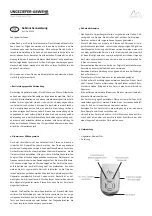
UniPOS
Fire Control Panel FS5100
Instruction Manual
Page 33
Revision 7/06.12
Of 47
18.2. Periphery devices assembly
All connections are to be made by means of terminals, mounted on the printed circuit boards
(Appendixes 4, 5 and 6). Be advised, that the consumption of the voltage powering the external
devices (terminal “+ 24V” on the basic module) shall not exceed 1.3A in heavy-duty mode. Here is
included the consumption of the controllable outputs powered by the same voltage.
18.2.1. Mounting periphery devices to controllable outputs
Terminals “+Out1”, “-Out1”, “+Out2”, “-Out2” of the Basic module are used – controllable,
potential outputs, responding upon Fire condition stage I or Fire condition stage II (depending on the
pre-programming of the relation fire alarm line – controllable outputs).
Use the special connection diagram for the executive device provided in Appendix 7c.
End of line resistors 5k6 are connected directly to the terminals of the unused controllable
outputs.
18.2.2. Mounting periphery devices to relay outputs
The following terminals are used:
- Terminal “+24V” of the Basic module – positive lead of the stabilized direct current supplying the
external devices (light and sound signaling devices, executing devices and others);
- Terminal “GND” of the Basic module – chassis ground (negative lead of the stabilized direct
current supplying the external devices);
- Terminals “Rel1/C”, “Rel1/NO”, “Rel1/NC”, “Rel2/C”, “Rel2/NO”
и
“Rel2/NC” of the Basic module,
“Rel3”, “Rel4”, and “Rel5” of Modules 5101 or 5102 – potential free relay contacts, responding at Fire
condition stage I or Fire condition stage II (in compliance with the pre-programming of the relation fire
alarm line – relay outputs). Contact’s type of terminals “Rel3”, “Rel4”, and “Rel5” is set by means of
“NC-NO” changeover of Module 5101 or 5102 (Appendixes 5 and 6);
- Terminals “REL Fault/C”, “REL Fault/NO” and “REL Fault/NC” of the Basic module – potential
free relay contacts. When no fault condition is detected terminals “REL Fault/C” and “REL Fault/NO”
are connected; upon detection of fault condition terminals “REL Fault/C” and “REL Fault/NC” are
conected.
The executve device shall be connected according to Appendix 7 d. Output type for the relay
outputs, situated on Module 5101 or 5102 is selected by means of jumpers – normally open (NO) or
normally closed (NC).
Unused relay outputs remain unoccupied.
18.3. Connecting interface units
To connect interface units you need a fire control panel with basic module that supports RS232 or
RS485 serial interface (delivered upon customer’s order). The interface units are connected to one of
the two interfaces, by means of 9 - lead coupling, available on the basic module. Signals distribution
is shown in Table 3.
Table 3
Coupling’s lead
Signal of RS232 Interface
Signal of RS485 Interface
2
RXD (input data)
Inverting input/output
3
TXD (output data)
Non inverting input/output
4
DTR
5
GND (chassis ground)
The fire control panel provides power supply to an external modem, if the feature has been
included in the order. The power supply is tapped on a two-pole terminal on the Basic module.
18.4. Connecting fire detectors
Fire detectors are connected to the fire control panel by means of two-wire insulated line of total
resistance up to 100
Ω
. Connection is made to the terminal of the corresponding modules (Appendixes
4, 5 and 6) – “+Lin1” “-Lin1”, “+Lin2”
и
“-Lin2” of the Basic Module, “+Lin3” “-Lin3”, “+Lin4” “-Lin4”,
“+Lin5” and “-Lin5” of Module 5101 or 5102; “+Lin6” “-Lin6”, “+Lin7” “-Lin7”, “+Lin8” and “-Lin8” of
Module 5102; observing the indicated polarity.
Automatic fire detectors of series FD8000 and FD3000 or compatible can be used (Appendix 7a).
To enable detection of Fault condition
Removed fire detector
diodes shall be mounted – for example
1N5819, to the indicated in Appendix 7a direction. To set up a fire alarm line with group addressing of















































